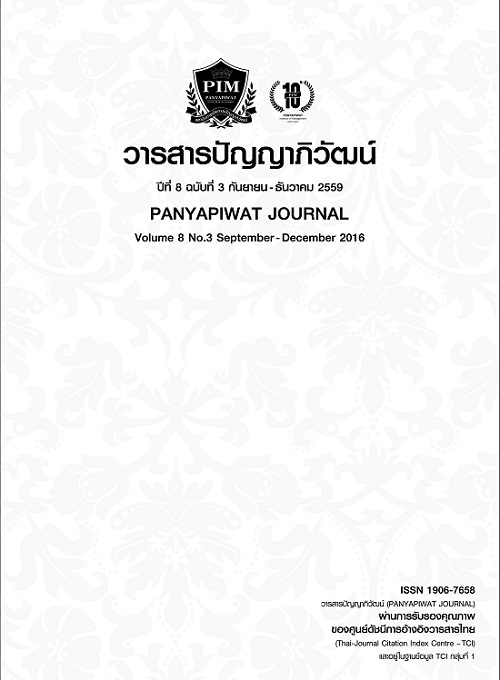พันธมิตรทางธุรกิจ: องค์ประกอบของการสร้างพันธมิตร กระบวนการเรียนรู้ และประสิทธิภาพในการดำเนินงานด้านพันธมิตร
Main Article Content
Abstract
ในช่วงระยะเวลาหลายปีที่ผ่านมา ธุรกิจมีความสนใจเข้าร่วมเป็นพันธมิตรทางธุรกิจกันมากขึ้น ด้วยความหวังว่าจะทำให้ธุรกิจมีสมรรถนะและประสบความสำเร็จเพิ่มขึ้น การใช้กลยุทธ์พันธมิตรทางธุรกิจก็ เพื่อที่จะแลกเปลี่ยนหรือแบ่งปันทรัพยากร และความสามารถระหว่างธุรกิจในการที่จะพัฒนาสินค้าหรือบริการร่วมกันเพื่อสร้างความได้เปรียบทางการแข่งขันเพิ่มขึ้น การสร้างพันธมิตรทางธุรกิจมีองค์ประกอบสำคัญที่จะทำให้ธุรกิจสามารถสร้างและรักษาความสัมพันธ์ระหว่างคู่พันธมิตรให้คงอยู่ไว้ได้และเกิดประสิทธิภาพในการบริหารจัดการ คือ 1) ความไว้วางใจ 2) ความผูกพัน 3) ความร่วมมือ 4) ประสบการณ์ด้านพันธมิตร และ 5) หน้าที่ด้านพันธมิตร นอกจากนี้การที่จะทำให้การเป็นพันธมิตรทางธุรกิจประสบความสำเร็จมากขึ้น ธุรกิจต้องมีการจัดการกระบวนการเรียนรู้จากพันธมิตร เพื่อนำความรู้ที่ได้รับจากการเป็นพันธมิตรไปใช้ในการพัฒนาความรู้ หรือการจัดการความรู้ที่จะเกิดขึ้นภายในองค์กร และสร้างความได้เปรียบทางการแข่งขันให้เกิดขึ้นกับองค์กรต่อไป
For many years that the businesses have expressed more interests to collaborate a business alliance with others as they hope that this collaboration will enhance their competency and bring more success to the business. The reason of using strategic alliances is to share or exchange resources and a capability to develop its product and service with the aim to improve its competitive advantage. Building business alliances will require importance elements which will allow business to be built and the business relation to be lasted among the alliances as well as to create efficiency in management. The elements are 1) Trust 2) Relationship 3) Cooperation 4) Alliances experience 5) Roles of the Alliances. Aside from the elements, to become more successful on Business Alliances, the business needs to manage the alliance learning process. This will bring knowledge received from Alliance to develop its own knowledge or the knowledge management and will create the competitive advantage to the organization.
Article Details
I and co-author(s) certify that articles of this proposal had not yet been published and is not in the process of publication in journals or other published sources. I and co-author accept the rules of the manuscript consideration. Both agree that the editors have the right to consider and make recommendations to the appropriate source. With this rights offering articles that have been published to Panyapiwat Institute of Management. If there is a claim of copyright infringement on the part of the text or graphics that appear in the article. I and co-author(s) agree on sole responsibility.
References
Aiken, M. & Hague, J. (1968). Organizational interdependence and intra- organizational structure. American Socio-logical Review, 33(6), 912-930.
Anand, B. & Khanna, T. (2000). Do firms learn to create value? The case of alliances, Strategic Management Journal, 21(3), 295-316.
Anderson, J. C. & Narus, J. A. (1990). A model of distributor firm and manufacturer firm working partnership. Journal of Marketing, 54(1), 42-58.
Barkema, H. G., Sheker, O., Vermeulen, F. & Bell, J. H. (1997). Working abroad, working with others: How firms learn to operate international joint ventures. Academy of Management Journal, 40(2), 426-442.
Child J. & Yan Y. (1999). Predicting the performance of international alliances: an investigation in China. Working paper, Chinese Management Centre, University of Hong Kong.
Cullen, B. J. & Johnson, L. J. (2000). Success through commitment and trust: The soft side of strategic alliance management. Journal of World Business, 35(3), 223-240.
Davidson, C. & Voss, P. (2002). Knowledge management. Auckland: Tandem Press.
Davis, J. H., Schoorman, F. D., Mayer, R. C. & Tan, H. H. (2000). The trusted general manager and business unit performance: Empirical evidence of a competitive advantage. Strategic Management Journal, 21(5), 563-576.
Dietz, G., Hartog, D. & Deanne N. (2006). Measuring trust inside organizations. Personnel Review, 35(5), 557-588.
Draulans, J., deMan, A. P. & Volberda, H. W. (2003). Building alliance capability: Management techniques for superior alliance performance. Long Range Planning, 36(20), 151-166.
Dyer, J., Kale, P. & Singh, H. (2001). How to make strategic alliances work. Slone Management Review, 42(4), 37-43.
Dyer, J. & Singh, H. (1998). The rational view: Cooperative strategy and sources of international competitive advantage. Academy of Management Review, 23(4), 660-679.
Gulati, R. (1999). Does familiarity breed trust? The implications of repeated ties for contractual choice in alliances. Academy of Management Journal, 38(1), 85-112.
Gundlach, G. T., Achrol, R. S. & Mentzer, J. T. (1995). The structure of commitment in exchange. Journal of Marketing,59(1), 78-92.
Heimeriks, K. & Duysters, G. (2007). Alliance capability as a mediator between experience and alliance performance: An empirical test into the alliance capability development process. Journal of ManagementStudies, 44(1), 25-49.
Hoang, H. & Rothaermel, F. T. (2005). The effect of general and partner-Specific alliance experience on joint R & D project performance. Academy of Management Journal, 48(2), 332-345.
Ireland, R. D., Hoskisson, R. E. & Hitt, M. A. (2013). The management of strategy: Concepts and cases (10th ed.). South-Western: Cengage learning.
Kale, P., Dyer, J. & Singh, H. (2002). Alliance capability, stock market response, and long-term alliance success: The role of the alliance Function. Strategic Management Journal, 23(8), 747-768.
Kale, P. & Singh, H. (2007). Building firm capabilities though learning: The role of the alliance learn-ing process in alliance capability and firm-level alliance success. Strategic Management Journal, 28(10), 981-1000.
Kingshott, R. P. J. (2006). The Impact of Psychological Contracts upon Trust and Commitment within Supplier-buyer Relationships: A Social Exchange View. Industrial Marketing Management, 35(6), 724-739.
Lyles, M. A. (1988). Learning among joint venture sophisticated firms. Management International Review, Special Issue(28), 85-98.
Mehta, R., Larsen, T., Rosenbloom, B. & Ganitsky, J. (2006). The impact of cultural differences in U.S. business-to-business export marketing channel strategic alliances. Industrial marketing Management, 35(2), 156-165.
Mohr, J. & Spekman, R. (1994). Characteristics of Partnership Success: Partnership Attributes, Communication Behavior and Conflict Resolution Techniques. Strategic Management Journal, 15(2), 135-152.
Rahatullah, K. M. (2014). Role of trust and commitment in building successful franchise business relationships. International Journal of Knowledge Innovation and Entrepreneurship, 2(1), 90-107.
Saxton, T. (1997). The effect of partner and relationship characteristics on alliance outcomes. Academy of Management Journal, 40(2), 443-461.
Schermerhorn, J. R. (1975). Determinants of inter-organizational cooperation. Academy of Management Journal, 18(4), 846-856.
Simonin, B. L. (1997). The Importance of collaborative Know-How: An empirical test of the learning organization. Academy of Management Journal, 40(5), 1150-1174.
Stern, L. W. & Reve, T. (1980). Distribution channels as political economies: A framework for comparative analysis. Journal of Marketing, 44(3), 52-64.
Wong, A. S. H., Tjosvold, D. & Zhang, P. (2005). Developing relationships in strategic alliances: Commitment to quality and cooperative interdependence. Industrial Marketing Management, 34, 722-731.


